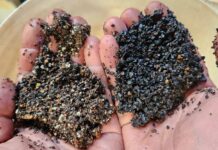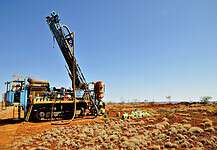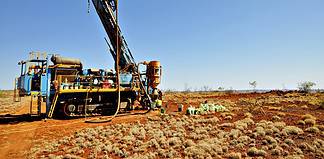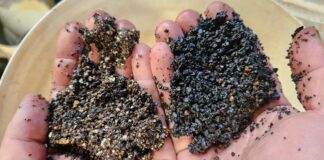All images: BCI Minerals.
BY ELIZABETH FABRI
WA-based BCI Minerals – formerly BC Iron – has a new name, a new focus, and a suite of high-quality projects in the Pilbara that will be hitting key development milestones over the coming year. BCI Minerals managing director Alwyn Vorster sheds light on the miner’s recent diversification strategy beyond iron ore to salt and sulphate of potash (SOP).
Q. The company changed its name last November. Was diversification the key driver of the rebrand?
The decision to diversify beyond just iron ore was a very deliberate one. BC Iron had just emerged from a fight for survival due to operating a single, higher cost iron ore mine (Nullagine) at a time when the iron ore prices were declining rapidly.
While Nullagine was very profitable at times, we didn’t want another near death experience for the company and viewed diversification as means to smoothing out the commodity price bumps.
Q. Has it been difficult to make the transition from an iron ore focussed miner to one more diversified? What challenges have you encountered?
BCI’s diversification strategy had two elements.
The first was to progress and add value to the non-iron ore assets that were already in the portfolio, and the second element was to target new assets in other commodities.
We have been very successful in advancing our existing assets and took the Mardie Project from a series of tenements with an idea, through to a completed Scoping Study and then pre-feasibility study on a major salt and sulphate of potash development opportunity within 18 months.
On the second element, we secured a joint venture interest in a SOP project with Kalium Lakes, which has now progressed through the Scoping Study phase.
However, we did face challenges in our aim to invest in more advanced stage non iron-ore projects. We attribute this to several factors, including BCI discipline in considering opportunities, the competitiveness in the gold space in particular, and the fact that favourable capital markets provide preferred funding options (rather than joint ventures).
Overall, we consider our diversification strategy to have been a success. In fact, we now consider ourselves a salt and SOP focused business supported by current and potential future iron ore earnings.
Q. Industry peers have also followed with their own diversification strategies. Do you think this is necessary given volatility in the iron ore market at the moment?
I think that diversification is a smart business decision generally, but it is interesting to note that other iron ore companies such as Fortescue and Atlas have also made efforts to diversify.
Like BCI, Atlas and to a lesser extent Fortescue also endured challenging times during the iron ore price decline, and perhaps see diversification as a longer term solution for mitigating this risk.
Not everyone agrees with this strategy, and particularly when you are a junior there is scepticism whether the company has the resources and focus required to make it a success.
Q. How important was securing Kumina last year for the development of your Buckland Iron Ore project?
The acquisition of Kumina was undoubtedly an important milestone for BCI, but not without risk given essentially no exploration has been conducted on the tenements for decades. However, we did the required conceptual due diligence work and were confident of its potential. Ultimately we have been proven right, given we have proven up resources on three deposits so far and there is excellent potential for more than 200mt of good quality iron ore to be discovered.
The success at Kumina is very important for BCI as it provides options. It has enhanced the prospects of Buckland being developed as an integrated operation but also means Kumina can be considered as a potential lower cost, higher grade standalone development.
We expect that type of development will appeal to a number of third parties, and we are currently in discussions with numerous parties.
Q. Are you any closer to formalising the non-binding MOU you entered with Sinosteel earlier this year?
We are continuing discussions with Sinosteel on the Buckland Project, and in particular on Kumina.
We have a strong working relationship and Sinosteel is showing genuine interest in the project. The potential for Sinosteel to become of joint venture partner in some or all of the Buckland assets is one of the options being discussed, and definitely a possibility.
The aim with the Buckland Project assets is to secure transactions that will create value and/or future earnings to support the development of our Mardie Salt & SOP Project.
We are therefore discussing the project with a number of interested parties.
Q. What is your current timeline for both Mardie and Buckland?
The Mardie feasibility study is planned to be completed and key approvals secured by the end of 2019, which could lead to construction during 2020.
In the meantime, we are planning to construct pilot ponds which will mimic the salt operations at Mardie.
We are aiming to have a transaction secured for Buckland within the next few months.
The nature of that transaction will then dictate the timeline for development of Kumina and potentially other Buckland assets.
Q. At the recent AMEC convention you said BCI was looking into development options for Mardie, including a JV or spinout. Can you elaborate on these two options?
The base case assumption is that BCI will complete the feasibility study outright. However, if an attractive funding or partnership opportunity arises, particularly if it is an existing large salt industry player, we will consider it seriously.
Q. What’s next for the Carnegie JV (BCI/Kalium Lakes) potash exploration project?
The Carnegie scoping study has now been completed and confirmed the potential for a technically and financially viable project.
The scoping study benefited substantially from the experience Kalium has gained in advancing its primary project, Beyondie.
BCI and Kalium have agreed to proceed to a staged pre-feasibility study for Carnegie, with the initial focus on securing tenure and access to all required tenements. This will enable the PFS to be undertaken on a much larger proportion of the Carnegie lake system.
Q. You mentioned BCI Minerals now considers itself a salt and SOP focused business. What is your outlook for these markets?
We view the markets for both salt and SOP as having strong medium to longer term fundamentals.
The market for high purity salt supplied into Asia is expected to become particularly tight over the next decade and we see the potential for a supply gap equal to approximately seven Mardie-sized projects to emerge by 2027.
The strong outlook for SOP as a high quality fertiliser is well documented against an underlying themes of an increasing global population, expanding middle class, and reduction in land available for food production.
Ultimately, BCI aims to become a serious player in the salt and SOP industries, through its involvement in Mardie, Carnegie, and potentially through other synergistic acquisitions.










































